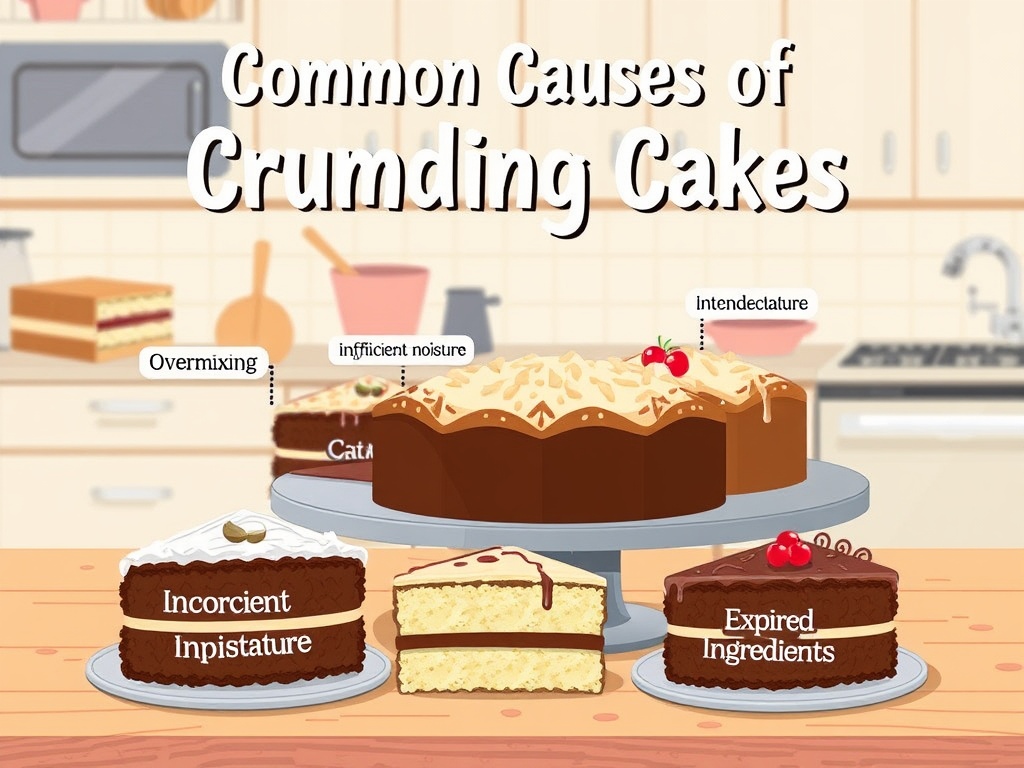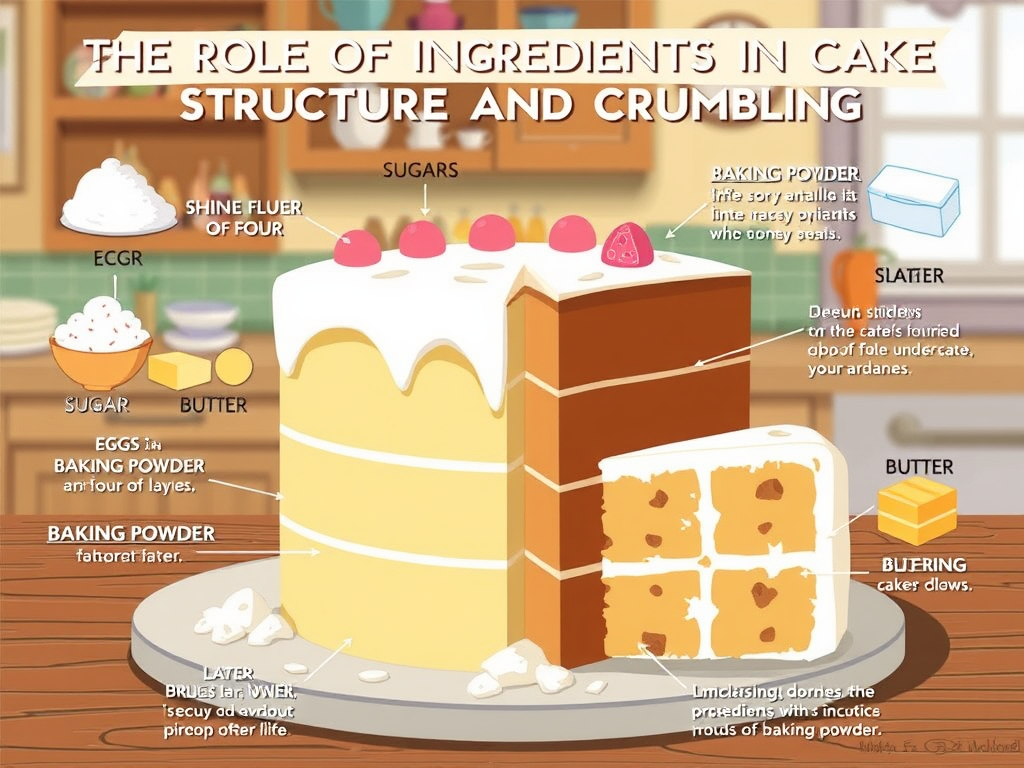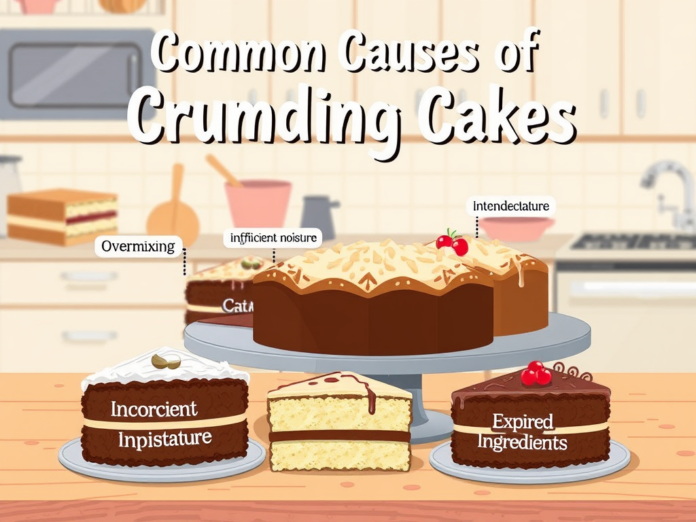1. Introduction
Baking is an art that brings joy and satisfaction, but sometimes, the perfect cake you expect turns out to be crumbly, causing disappointment for the baker. The issue of a cake crumbling after baking is common, and to fix this, we need to understand the underlying causes of this phenomenon and master the correct baking techniques.
This article will explore the scientific factors and practical steps to help you create soft, moist cakes with a solid structure that don’t crumble. With an understanding of the role of each ingredient, mixing techniques, baking temperature, and how to cool the cake, you can confidently master any cake recipe and always succeed with delicious, crumb-free cakes.
2. Common Causes of Crumbling Cakes

One of the main causes of cakes crumbling is excessive dryness. This usually happens due to two primary reasons: using too much dry ingredient or baking the cake for too long.
Using too much dry ingredient, especially flour, is a key factor. Flour absorbs moisture, and if the amount of flour in the recipe is too much compared to the wet ingredients, the cake will be dry. Other dry ingredients like cocoa powder and sugar can also contribute to the cake crumbling.
Improper mixing technique is another crucial factor. Over-mixing will excessively activate gluten development, making the cake chewy and then crumbly. On the other hand, insufficient mixing can leave ingredients unevenly distributed, leading to a weak cake structure that is prone to crumbling.
Too high oven temperature can also cause the cake to crumble. Finally, not allowing the cake to cool completely before cutting or decorating is another reason why cakes can break apart easily.
3. The Role of Ingredients in Cake Structure and Crumbling

Flour:
Flour forms the framework of the cake through gluten protein. When mixed with liquid, gluten forms an elastic network that helps the cake achieve a certain chewiness. However, using too much flour will result in a dry, crumbly cake.
Fats (Butter, Oil):
Fats help soften the cake, retain moisture, and reduce gluten formation. However, if too much fat is used, the cake’s structure will weaken, making it more likely to crumble.
Eggs:
Eggs bind different ingredients together, providing moisture and fat from the yolks, which helps make the cake softer. If eggs are lacking, the cake may not have enough binding properties and will be more prone to crumbling.
Sugar:
Sugar attracts moisture, helping the cake stay softer. However, if used in excess, it can make the cake brittle and prone to breaking.
Liquids (Milk, Water, Fruit Juices):
Liquids activate leavening agents and provide moisture to the cake. The balance between liquids and dry ingredients determines the cake’s moisture and crumbliness.
4. Choosing the Right Type of Flour

The type of flour you choose significantly impacts the cake’s texture, especially its softness and tendency to crumble. Different flours have varying protein content, and this protein determines the amount of gluten that forms during mixing.
Comparison Table of Common Flours Used for Baking:
| Type of Flour | Protein Content (%) | Cake Texture | Crumbly Potential | Notes |
|---|---|---|---|---|
| Cake Flour | 6-10 | Very fine, soft, airy, light | High (potential) | Best for sponge cakes; requires moisture balance. |
| Pastry Flour | 7-10 | Soft, fine, slightly airy | Medium | Good balance between softness and structure. |
| All-Purpose Flour | 9-12 | Coarser, good structure | Medium | Versatile; easy to find. |
| Bread Flour | 12-15 | Chewy, firm | Low | Not recommended for sweet cakes. |
| Self-Raising Flour | Similar to cake flour | Fine, soft, airy | Similar to cake flour | Good alternative when cake flour is unavailable. |
5. Proper Mixing Techniques
The technique of mixing the batter plays a crucial role in determining the structure of the cake.
- Over-mixing: Excessively activates gluten, making the cake chewy, dry, and crumbly. Mix gently until the ingredients are just combined.
- Under-mixing: Ingredients are not evenly distributed, leading to a weak structure and crumbling.
Tips for Mixing Batter Properly:
- Mix wet ingredients first, then gradually add dry ingredients.
- Sift flour before mixing to avoid lumps.
- When adding flour to the wet mixture, mix at a low speed if using an electric mixer.
- Use a spatula to mix gently during the final stage.
6. Proper Baking Techniques
Baking temperature and time have a significant impact on the cake’s structure.
- Too high temperature: The cake’s surface bakes too quickly, while the inside remains unstable, leading to dryness and crumbling.
- Baking for too long: Causes moisture to evaporate, making the cake dry.
Tips for Proper Baking:
- Always preheat the oven before baking.
- Check the cake with a toothpick: If it comes out clean, the cake is done.
- Avoid opening the oven too often during baking to prevent sudden temperature changes.
7. Conclusion
Crumbly cakes are not a difficult problem to fix if you understand the causes and apply the correct baking techniques. From ingredient selection and batter mixing to controlling baking temperature and cooling methods, each step is crucial to ensuring the cake doesn’t become dry and crumbly.
With these tips and knowledge, you will be able to create perfect cakes that are soft, delicious, and crumb-free. Good luck! 🎂
























